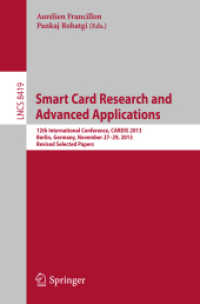- ホーム
- > 洋書
- > ドイツ書
- > Humanities, Arts & Music
- > History
Full Description
As the first inter-disciplinary study of ethnic relationship and cultural changes in the westernmost section of the Tibetan-Yi Corridor, this book brings together a broad range of analyses from the anthropological, historical, and frontier studies perspectives. The author builds on a synthesis of Fei Xiaotong's Tibetan-Yi corridor theory and Wang Mingming's cultural theory and to present a rich historical narrative of the dynamic interactions among the Lisu, Nu, Dulong, Naxi, Bai, Tibetan and Pumi ethnic groups in this region from the Tang Dynasty to the Republic of China period. In addition to a vast body of existing literature, the study also draws on extensive fieldwork. Its findings not only enhance our knowledge of the historical development of particular ethnic groups in a specific region but also have implications for how we should understand the development of the Chinese nation as a whole.
Contents
List of Figures - List of Tables - Introduction - Ethnic Groups in the Western Area of the Tibetan-Yi Corridor after Battles among Three Parties in the Tang Dynasty - Eight Southern Tribes in Lijianglu after Yuan Soldiers Crossed Jinsha River using Animal Bladders as a Floatation Device - The Rise of the Mu Clan during the Ming Dynasty and Ethnic Groups in the Western Area of the Tibetan-Yi Corridor - Ethnic Groups on the Western Edge of the Tibetan-Yi Corridor against the Decline of the Local Chieftains of the Mu Clan in the Qing Dynasty - The Ethnic Groups along the Tibetan-Yi Corridor during the Crisis in the Period of the Republic of China - Ethnic Relations and Changes in Ethnic Culture - Bibliography.








